Nostalgic Game Design Focus - 1943: The Battle of Midway
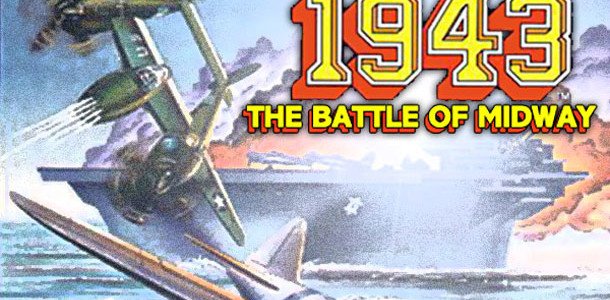
Source
Here is one of the most classic 90s arcade games right here! Its you against the entire Japanese fleet in the intense battles near and above the Midway Islands during World War II.
Welcome. This is 'Nostalgic Game Design Focus' a series where I get to think back and comment upon games that I had played when I was much younger - mostly from a game-design perspective.
Title: 1943: The Battle of Midway
Publishers: GO! Probe.
Developer: Capcom
Released: 1988
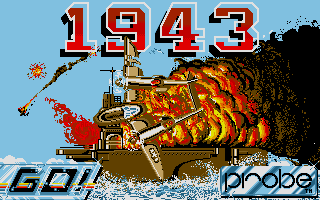
Source
'1943: The Battle of Midway' was one of those games that was simply 'part of my video game library'. It didn't particularly stand out - thanks to the competition in my diskettes box.
However I did enjoy playing this game and... for me it really was just a game.
When you are young you don't really question what you are doing.
I didn't see myself shooting at 'Japanese' planes and ships.
All I saw was 'bad guys' that I shot down for the points.
Its only many years later that I reflect upon such.
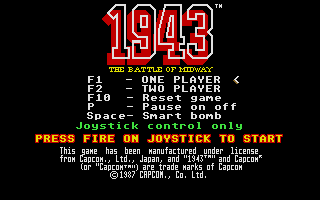
Source
Story and Aim of the Game
The premise of '1943: The Battle of Midway' is that you assume control of a single P-38 plane tasked with taking on the entire Japanese navy during the critical period when the tides were turning against Japan.
The history goes that due to the heavy defeat of Japan's navy, Japan was no longer in a position to pursue military ambitions beyond its shores (which kind of puts a crimp into necessity of using the atomic bomb to coerce surrender - but I digress - that is a discussion for a non-game-related post).
Well, the aim of the game is to survive a number of increasingly intense levels, taking out Japanese planes and then the Japanese fleet itself.
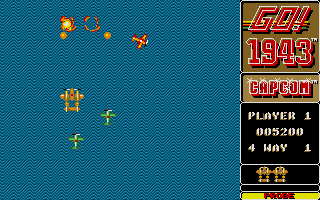
Source
Game Design
Game controls for the player are quite straightforward.
Joystick controls allows 8-way movement on screen.
Pressing the fire button shoots.
Pressing the 'space bar' deploys a 'smart bomb' that kills or damages all enemies on screen.
During the game opportunities will arise for a player to pick up power-ups that will greatly help with the task at hand.

Source
Actually, Lets Talk Power-Ups
At certain points one would see these floating downwards from the top of the screen to the bottom. They could be missed.
One innovative aspect about these power-ups is that shooting them sees them change and cycle to something else. This meant that one could have a fair degree of control over what one got out of them.
Auto - Automatic Fire. A little more effective at close range.
Multi-way - An additional projectile fires both to the right and left forward arc.
Flame-shot - Similar to the Multi-way but each shot is more powerful and it alternate-fires two shots at a time.
Missiles - Single-file projectile that is very fast, powerful, but has the lowest spread.
Fuel - Increases Energy 'and' powers up the weapon for about 20 seconds.
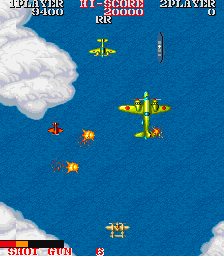
Source
Level Design
One might wonder how much level design could possibly go into a vertical shooter.
After all, in this game you are flying above it all, with no annoying walls to bump into, unless one counts bullets and other planes.
Well, one thing that this game did 'really' well is delivering on the illusion that one is flying over the Pacific Sea - and Pacific Islands. In truth what was actually going on was that the same chunks of sea were being repeated to form an seascape. At times, predetermined by how far along one has gotten in the level, the game would throw larger images of islands to reinforce the illusion that it isn't just endless sea. The use of zig-zag patterns to represent the sea itself was also a really good idea because a pattern can be used to give the illusion of motion. Thus, from a purely aesthetic perspective, you 'were' flying over and around the Midway Islands.
Other than this, 'Capcom' ensured that the skies themselves weren't boring, with an orchestrated series of attack waves to keep you and your little plane company. Often these would be small planes flying in from any direction, sometimes changing course mid-screen (if still alive). Larger planes would also get in on the action, being more aggressive with the firepower that they lay down. Ships of various sizes and armaments would also feature following each level - and each level the lineup got longer and more deadly.
The timing and location of power-ups were also another thing to factor in - especially considering the way they worked.

Source
One shortcoming of the game was a lack of variance.
Every wave happens precisely as scripted.
While true random number generation was too sketchy to consider as genuinely random, it might have been possible to alter the behavior and patterns of enemy waves on the basis of a number of things that are out of the computer's control. Namely the position, health smart bombs and number of lives of the player, hit percentiles, etc.
Even if such variances might have been minor - maybe an extra wave here or there - or different attack behaviors or spawn patterns - such would have made this game that much more replayable.
That being said, 1943: The Battle of Midway implements its scripted waves very well.
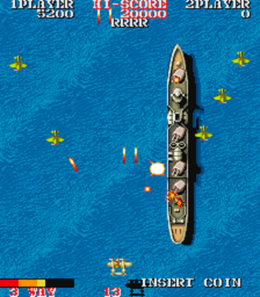
Source
A Word on Atmosphere
This game strikes a balance between charm and challenge.
You won't want to spend much time admiring the simple island images as you fly past them - but thats alright - you have a battle to win.
The ship sprites in particular are great - and you get a real sense of the menace that those turrets pose as they fire volleys of bullets at you.
On a different note, the music in this game is thematically accurate and pleasant to listen to. Even though there is only a single song in the whole game - it really is easy on the ears and would listen to it for hours without being in the least disturbed.
The game is quite well made, even if short, and retains a charm to this day.
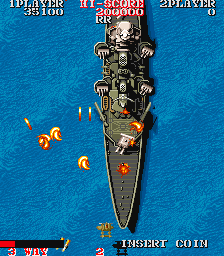
Source
As always, here follows a faithful representation of the game in video format. It is well worth a play or three and I do feel that it sets a good model for other vertical shooters to follow.
Looking back at history with nostalgia. Sometimes even seemingly simple games can provide lessons. It is hoped that you all enjoyed taking a look though this as much as I did writing it. :c)
Do you have any comments or feedback? I look forward to hearing any comments that you have in the discussion down below!
Also, if you found this post interesting and would like to share this with your followers and friends then a resteem is always appreciated.
Previous Post: Taking Stock of My Path in 2017 Thus-Far

Love this game. It's the shooter that made me love/hate shooters.
A lot of 90s persons will likely remember this one. I personally remember it gracing a couple of restaurant waiting areas all the way up to the turn of the century. ^_^
Thank you kindly for your upvote and for stopping by. :c)